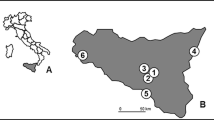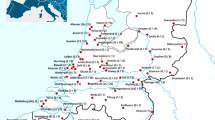Abstract
Palynological analysis of the organic contents of ceramic pots from the Kodiani burial mound, which is dated as 27th-25th centuries B.C., revealed that they contained honey. The samples are extremely rich in excellently preserved pollen grains, including numerous pollen grains of insect-pollinated plants. Such characteristics are typical of palynological assemblages from honey. The palynological assemblages from three pot fragments studied are dominated by pollen grains of Rosaceae; however, they differ from one another in the subdominants. The discovery of several kinds of honey testifies to the presence of well-developed beekeeping in the time of the Early Kurgans. Agriculture, with a significant role of wheat, was also developed in the region of Georgia under study. According to the composition of the palynospectra, the ecological conditions that existed during the epoch studied differ significantly from the present day.
Similar content being viewed by others
References
Z. Asanidze, “The Investigation of Honey by Using of Palynological Method,” in Abstracts of the 65th Conference of Students of Biological Department, Tbilisi (Javakhishvili Univ., Tbilisi, 2005), pp. 11–12.
V. A. Demkin, “The Use of Phosphate Method for the Reconstruction of Funeral Food in Figulines from Burial Mounds of the Steppe Zone,” Tr. Gos. Istor. Mus. 120 (Seasonal Economic Cycle of the Population of the Northwestern Caspian Region in the Bronze Age), 100–107 (2000).
J. N. Dickson, “Bronze Age Mead,” Antiquity 52, 108–113 (1978).
W. Groenman-van Waateringe, “Palynological Investigations of Five German Burial Mounds,” Archaeo-Physica 8, 69–84 (1979).
A. A. Grossgeim, Vegetative Resources of the Caucasus (Akad. Nauk Azerb. SSR, Baku, 1946) [in Russian].
G. Inanishvili, Foundations of Technical Appraisal of Antiquity (Tbilis. Tekhn. Univ., Tbilisi, 2003) [in Georgian].
E. Konigsmann, “Insekten,” in Urania Tierreich (Urania, Leipzig-Jena-Berlin, 1978), pp. 381–392.
U. Körber-Grohne, “Die biologischen Reste aus dem hallstattzeitlichen Furstengrab von Hochdorf, Gemeinde Eberdingen (Kreis Luudwigsburg),” Forsch. Vor-Fruhgesch Baden-Wurtt 19, 85–265 (1985).
B. A. Kuftin, Archeological Excavations in 1947 in the Tsalkinskii District (Akad. Nauk Gruz. SSR, Tbilisi, 1948) [in Russian].
B. A. Kuftin, Archeological Route Expedition in 1945 in South Ossetia and Imeretia (Akad. Nauk Gruz. SSR, Tbilisi, 1949) [in Russian].
E. Kvavadze, “Annual Modern Pollen Deposition in the Foothills of the Lagodekhi Reservation (Caucasus, East Georgia),” Related to Vegetation and Climate, Acta Palaeobot. 21(2), 355–366 (2001).
E. V. Kvavadze and S. E. Connor, “Zelkova carpinifolia (Pall.) K. Koch in Holocene Sediments of Georgia—an Indicator of Climatic Optima,” Rev. Palaeobot. Palynol. 133, 69–84 (2005).
E. V. Kvavadze, I. Yu. Gambashidze, G. M. Mindiashvili, and G. K. Goguchuri, Traces of Existence of Ancient Beekeeping (3rd Millennium B.C.) in the Territory of Georgia Based on Palynological Data (Universal, Tbilisi, 2004c) [in Russian].
E. Kvavadze, Z. Shatberashvili, J. Amiranashvili, et al., “The First Results of Palynological and Palaeocarpological Studies of Tkemlara (Tetritsako Region) Burial Mound Sediments,” J. Dziebani., No. Suppl., 17–29 (2004a) [in Georgian].
E. Kvavadze, Z. Shatberashvili, J. Amiranashvili, and G. Arabuli, “Palynological Investigation of Two Burial Mounds of the Middle Bronze Age of Tkemlara (South Georgia),” Acta Palaeobot. 44(2), 267–279 (2004b).
V. P. Lominadze and G. I. Chirakadze, Climate and Climatic Resources of Georgia (Gidrometeoizdat, Leningrad, 1971) [in Russian].
A. Lucas, Ancient Egyptian Materials and Industries, 3rd ed. (London, 1958).
L. I. Maruashvili, Geomorphology of Georgia (Metsniereba, Tbilisi, 1971) [in Russian].
G. Mindiashvili, F. Murvanidze, F. Ramishvili, and G. Chikovani, “Archeological Excavation at the Export Pipeline of the Western Direction of 143rd Kilometer,” in Archaeology of the Pipeline, Ed. by V. Licheli (Tsentr Arkheol. Issled. Akad. Nauk Gruz., Tbilisi, 2003), Vol. 2, pp. 65–69 [in Georgian].
T. A. Rabotnov, Grassy Plants of the USSR (Mysl’, Moscow, 1971), Vol. 2 [in Russian].
A. Robakidze, On the History of Beekeeping (Akad. Nauk Gruz. SSR, Tbilisi, 1960) [in Georgian].
M. Rösch, “Evaluation of Honey Residues from Iron Age Hill-top Sites in South-western Germany: Implications for Local and Regional Land and Vegetation Dynamics,” Veget. Hist. Archaeobot., No. 8, 105–112 (1999).
M. Rösch, “Der Inhalt der beiden Bronzekannen,” in Das Ratsel der Kelten vom Glauberg: Glaube-Mythos-wirklichkeit (Konrad-Theiss, Stuttgart, 2002), pp. 119–120.
N. I. Shishlina, V. A. Demkin, and A. A. Bobrov, “Analysis of the Feeding System of Steppe Inhabitants of the Northwestern Caspian Region in epoch of the Bronze Age and Early Iron Age,” in Ostrovnoi Burial: Results of Complex Study of Archaeological Sites of the Northwestern Caspian Region, Ed. by N. I. Shishlina and E. V. Tsutskin (Elista, Moscow, 2002), pp. 314–323 [in Russian].
V. Ya. Stanek, Illustrated Encyclopedia on Insects (Artiya, Prague, 1977) [in Russian].
W. van Zeist, “Archaeology and Palynology of the Netherlands,” Rev. Palaeobot. Palynol. 4, 45–65 (1967).
Author information
Authors and Affiliations
Rights and permissions
About this article
Cite this article
Kvavadze, E.V. The use of fossilized honey for paleoecological reconstruction: A palynological study of archeological material from Georgia. Paleontol. J. 40 (Suppl 5), S595–S603 (2006). https://doi.org/10.1134/S0031030106110074
Received:
Issue Date:
DOI: https://doi.org/10.1134/S0031030106110074




